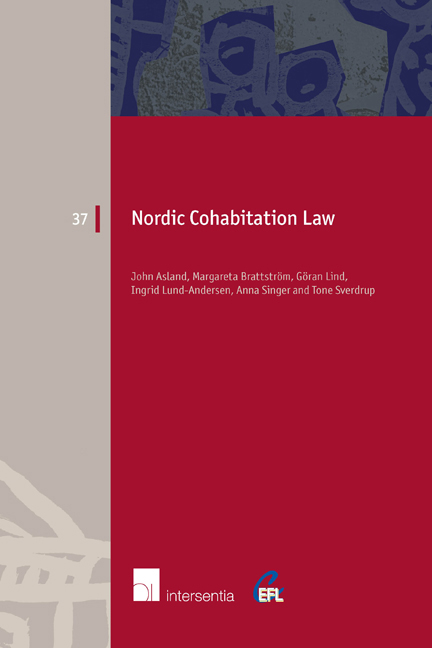Book contents
- Frontmatter
- Preface
- Contents
- Table of Cases
- List of Abbreviations
- Chapter 1 The Development of Cohabitation and Cohabitation Law in the Nordic Countries
- Chapter 2 Property Issues in Cohabitation Relationships
- Chapter 3 Financial Settlements on Termination of Cohabitation
- Chapter 4 The Legal Position of the Surviving Cohabitant
- Chapter 5 The Relevance of Cohabitation for Parental Rights
- Chapter 6 The Distinctive Legal Nature of Cohabitation Relationships and the Need for Legislation
- Chapter 7 Discussion of Legal Policy: Principles for Regulating Cohabitation Relationships
- References
- About the Authors
- European Family Law Series
Chapter 7 - Discussion of Legal Policy: Principles for Regulating Cohabitation Relationships
Published online by Cambridge University Press: 13 December 2017
- Frontmatter
- Preface
- Contents
- Table of Cases
- List of Abbreviations
- Chapter 1 The Development of Cohabitation and Cohabitation Law in the Nordic Countries
- Chapter 2 Property Issues in Cohabitation Relationships
- Chapter 3 Financial Settlements on Termination of Cohabitation
- Chapter 4 The Legal Position of the Surviving Cohabitant
- Chapter 5 The Relevance of Cohabitation for Parental Rights
- Chapter 6 The Distinctive Legal Nature of Cohabitation Relationships and the Need for Legislation
- Chapter 7 Discussion of Legal Policy: Principles for Regulating Cohabitation Relationships
- References
- About the Authors
- European Family Law Series
Summary
INTRODUCTION
Nordic cooperation: There is a long tradition of trying to harmonise family law throughout the Nordic region. Nordic cooperation is based on two factors: a common culture, religion and social structures that go back many hundreds of years; and the Scandinavian languages that have great similarities.
Cooperation on family law: The first meeting of Nordic lawyers took place in 1872. Since then lawyers have met regularly to discuss how legal cooperation between the Nordic countries can be developed and can give inspiration to their neighbour countries. Cooperation in the field of family law was especially intense when new legislation on marriage was being drafted at the beginning of the twentieth century. This led to Denmark, Iceland, Norway and Sweden introducing deferred community of property (gift orättsgods) as a matrimonial property regime at approximately the same time.
Harmonisation of the legal status of homosexual couples: In recent years there has been a high degree of harmonisation of the legal status of homosexual couples. In 1989 Denmark was the first country in the world to introduce legislation on registered partnerships, and the other Nordic countries have since introduced similar legislation: Norway in 1993; Sweden in 1994; Iceland in 1996; and Finland in 2001. But the development has not stopped there. Many in the Western world wanted same-sex couples to be given full equality with heterosexual couples, and this led to homosexual couples being given the right to marry in the Netherlands in 2001 and in Belgium in 2003. In the Nordic region Norway was the first country to adopt unified legislation for couples of the same sex and of different sexes in 2008. Sweden and Iceland followed soon after in 2009 and 2010 respectively, followed by Denmark in 2012. Finally, on 20 February 2015 the Finnish president signed a law allowing gender-neutral marriage. While legislation in the Nordic countries may have moved at different speeds, it has clearly moved in the same direction. Harmonisation has led to there being an almost identical legal situation throughout the Nordic region as regards homosexual couples.
Development of the legal status of unmarried cohabiting couples: In this book we have described how the legal status of unmarried cohabiting couples in the Nordic countries has developed. There are two clear aspects to this. First, the legal development has proceeded in a very different way than for couples of the same sex.
- Type
- Chapter
- Information
- Nordic Cohabitation Law , pp. 267 - 282Publisher: IntersentiaPrint publication year: 2015



